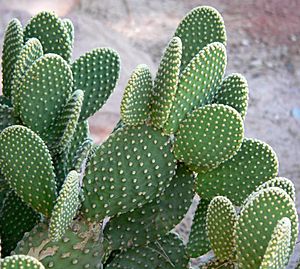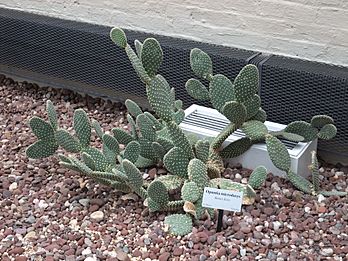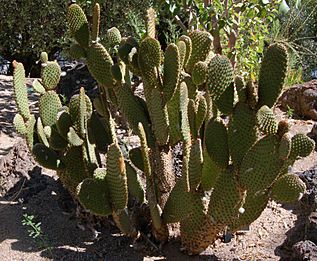Angel's-wings facts for kids
Quick facts for kids Angel's-wings |
|
|---|---|
 |
|
| Conservation status | |
| Scientific classification | |
| Genus: |
Opuntia
|
| Species: |
microdasys
|
Opuntia microdasys is a super cool type of cactus! You might know it by its fun nicknames like angel's-wings, bunny ears cactus, bunny cactus, or polka-dot cactus. It's a plant that grows naturally in central and northern Mexico.
Contents
About the Bunny Ears Cactus
This cactus usually grows into a bushy plant. It can be about 40 to 60 centimeters (that's about 1.5 to 2 feet) tall. Sometimes it can even grow taller! It has flat, pad-like stems that are usually 6 to 15 cm long and 4 to 12 cm wide.
What are Glochids?
Instead of sharp spines, Opuntia microdasys has tiny, hair-like bristles called glochids. These glochids are usually white or yellow. They are only about 2 to 3 millimeters long and grow in thick clusters.
Be careful though! These tiny bristles are barbed, meaning they have tiny hooks. They are also thinner than human hair. They can easily come off if you touch the plant, and they can cause a lot of skin irritation. So, it's best to look at this cactus without touching it!
The scientific name microdasys comes from Latin. It means "small and hairy," which perfectly describes those tiny glochids!
Flowers and Popularity
The Opuntia microdasys doesn't often grow flowers. When it does, they are usually yellow. Even without many flowers, this cactus is very popular to grow in gardens and homes. One reason is that young plants can look a lot like a rabbit's head, which is pretty funny!
This cactus has even won an award! It received the Royal Horticultural Society’s Award of Garden Merit.
Where it Lives
This cactus is originally from Mexico. But it has also started growing naturally in other places. You can find it in countries like Kenya, Malawi, and Tanzania.
How it Collects Water
One reason Opuntia microdasys does so well in dry desert places is its amazing ability to collect fog. Its tiny hairs have a special shape and structure. This helps them capture tiny water droplets from the fog and guide them down to the plant. It's like having its own built-in water collector!
Similar Cacti
There's a cactus that looks very similar to Opuntia microdasys. It's called Opuntia rufida. The main difference is that Opuntia rufida has reddish-brown glochids instead of white or yellow ones.
Opuntia rufida grows a bit further north in Mexico and also in western Texas. Some scientists think these two cacti might actually be the same species.
Species Comparison Gallery
See also
 In Spanish: Opuntia microdasys para niños
In Spanish: Opuntia microdasys para niños




